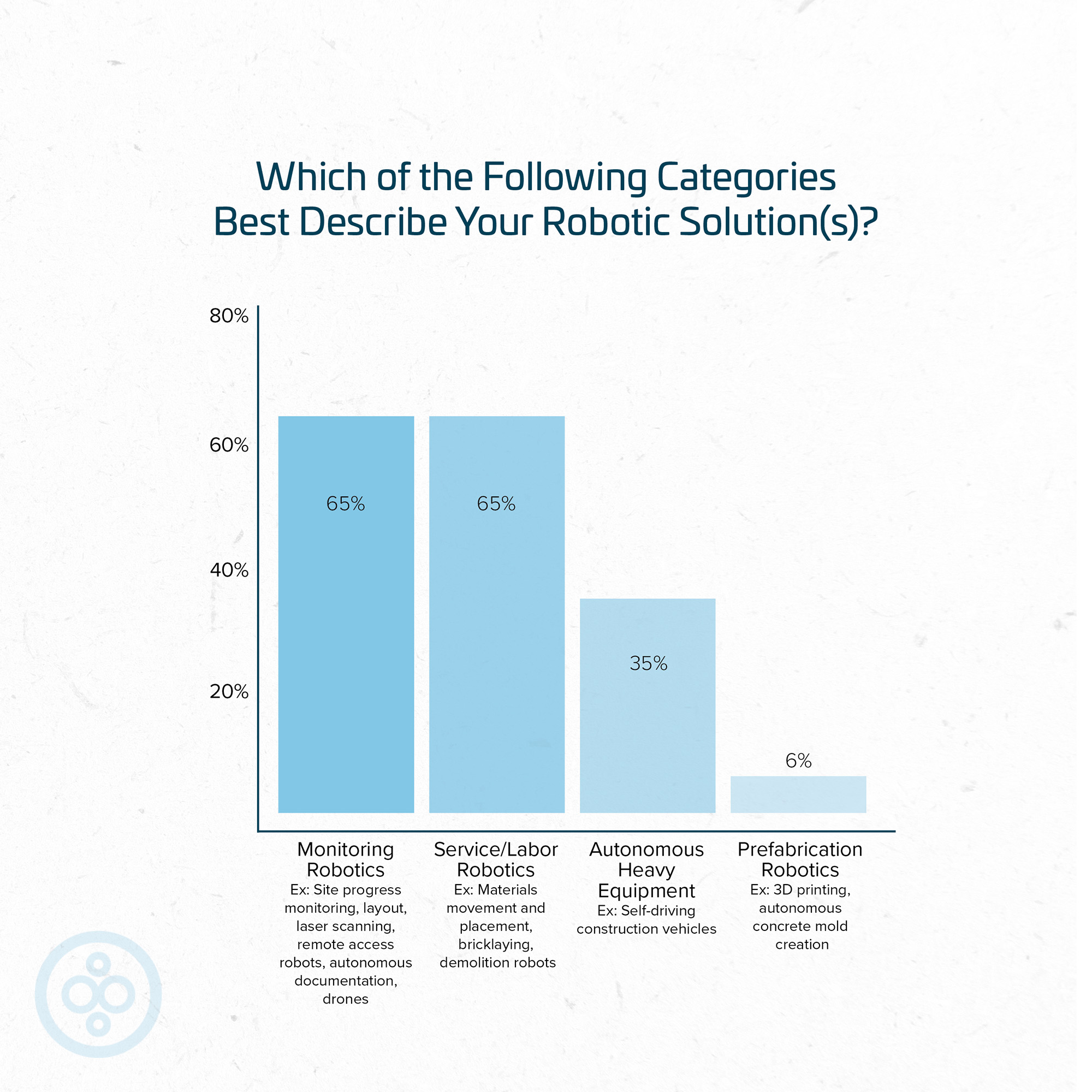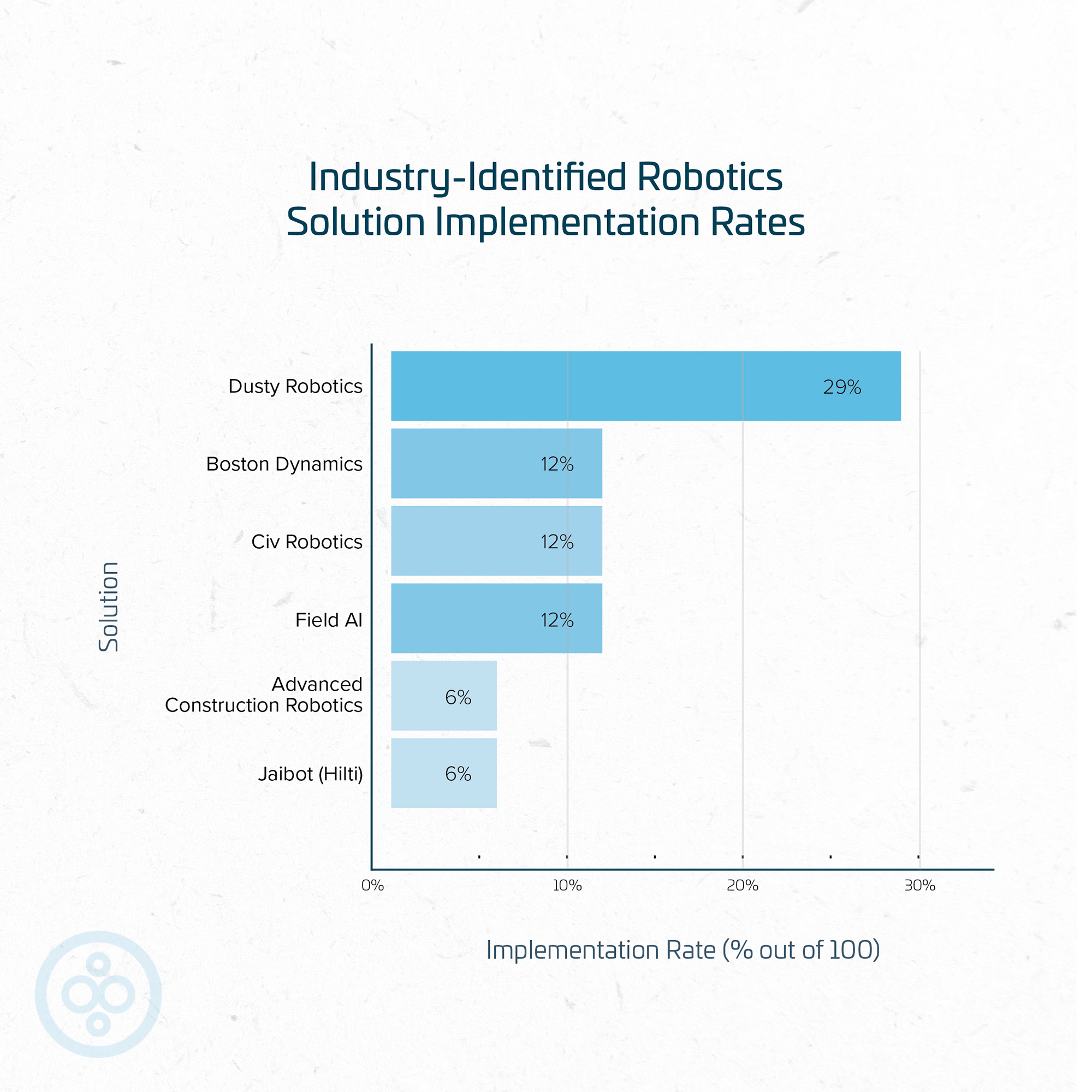BuiltWorlds, a member network dedicated to inspiring and advancing innovation in the AEC industry, has released its 2024 Tools, Equipment, and Robotics Benchmarking Report, an annual report that presents user survey data on category-specific technology adoption and usage. The report revealed that while the industry has been slow to adopt robotic solutions en masse, there has been considerable progress in certain areas, with one provider in particular seemingly pulling ahead as the preferred provider.
“The integration of advanced tools, equipment, and robotics represents a significant leap toward modernizing and streamlining operations within the AEC industry,” wrote BuiltWorlds Research Analyst Audrey Lynch, who authored the report. “This year, we saw the highest levels of adoption in monitoring robotics and service/labor robotics, two of the four main categories we've identified in construction robotics”
Nearly two-thirds of contractors surveyed, who cited use of robotics on jobsites, are either using monitoring and/or service/labor robotics. Thirty-five percent admitted to using autonomous heavy equipment, and a paltry 6% prefabrication robotics.

“There is a confluence of factors that are all working in tandem to drive increased utilization of robotics in the construction industry. The primary push forward is an increasingly prominent labor shortage in the industry,” said Tyler Sewall, Senior Director of Research for BuiltWorlds. He added, “Meanwhile, the typical barriers to adoption are slowly waning, leading to an environment more receptive to robotic solutions. The increased use of BIM, improved operability and accuracy, improved data collection and utilization, and an industry more culturally inclined to new technologies have all yielded material increases in the use of robotics.”
A Leading Provider in Dusty Robotics
Among the multiple robotic technology solutions providers named in the report, one provider stood out as both most implemented as well as highest rated: Dusty Robotics, a company that builds robots to help in laying out jobsites.
“Dusty Robotics consistently outperforms the industry average across all evaluated criteria, indicating its strong market position,” Lynch wrote. “With top ratings in adoption/utilization, ease of use, coordination with site activities, and data integration, the solution demonstrates its effectiveness and user-friendliness. It also excels in installation/performance speed and quality (tied with Civ Robotics), highlighting its reliability and efficiency.”

Why ‘Better Adoption’ Isn’t ‘Mass Adoption’
But while this year’s report shows wider scale adoption than years previous, particularly in the areas of service/labor and monitoring robotics, the industry has yet to embrace robotics into its mainstream.
“As much as the case for robotics continues to grow,” Sewall said, “there are, frankly, still so many reasons why robotics adoption isn't widespread, and may not be for a while.”
For one, most robotic solutions, he explained, require some variety of building model in order to operate.
“BIM, while well-adopted in some markets, is significantly underutilized in large portions of the industry.”

Another reason, Sewall shared, is that robotics, like any new technology, comes with a certain amount of risk—which is a problem in a traditionally risk averse industry.
“With layout robots, for instance, the second question is always, ‘Who owns the layout,’” he explained. “If the general contractor dictates how layout will be done, does that change the owner of the risk?”
Finally, and most obviously, is the cost.
“The up-front costs of robotic solutions are expensive,” Sewall said. “While larger companies can support these costs, many small- and mid-sized contractors simply cannot support any additional spend.”
Still, while there remain significant barriers to mainstream adoption of construction robotics, the data seems to indicate a slow acceptance and utilization of a technology that represents a massive boost to safety, efficiency, and productivity.
Related Stories
Sports and Recreational Facilities | Mar 7, 2024
Bjarke Ingels’ design for the Oakland A’s new Las Vegas ballpark resembles ‘a spherical armadillo’
Designed by Bjarke Ingels Group (BIG) in collaboration with HNTB, the new ballpark for the Oakland Athletics Major League Baseball team will be located on the Las Vegas Strip and offer panoramic views of the city skyline. The 33,000-capacity covered, climate-controlled stadium will sit on nine acres on Las Vegas Boulevard.
Adaptive Reuse | Mar 7, 2024
3 key considerations when converting a warehouse to a laboratory
Does your warehouse facility fit the profile for a successful laboratory conversion that can demand higher rents and lower vacancy rates? Here are three important considerations to factor before proceeding.
Shopping Centers | Mar 7, 2024
How shopping centers can foster strong community connections
In today's retail landscape, shopping centers are evolving beyond mere shopping destinations to become vibrant hubs of community life. Here are three strategies from Nadel Architecture + Planning for creating strong local connections.
Market Data | Mar 6, 2024
Nonresidential construction spending slips 0.4% in January
National nonresidential construction spending decreased 0.4% in January, according to an Associated Builders and Contractors analysis of data published today by the U.S. Census Bureau. On a seasonally adjusted annualized basis, nonresidential spending totaled $1.190 trillion.
MFPRO+ Special Reports | Mar 6, 2024
Top 10 trends in senior living facilities for 2024
The 65-and-over population is growing faster than any other age group. Architects, engineers, and contractors are coming up with creative senior housing solutions to better serve this burgeoning cohort.
Office Buildings | Mar 5, 2024
Former McDonald’s headquarters transformed into modern office building for Ace Hardware
In Oak Brook, Ill., about 15 miles west of downtown Chicago, McDonald’s former corporate headquarters has been transformed into a modern office building for its new tenant, Ace Hardware. Now for the first time, Ace Hardware can bring 1,700 employees from three facilities under one roof.
Green | Mar 5, 2024
New York City’s Green Economy Action Plan aims for building decarbonization
New York City’s recently revealed Green Economy Action Plan includes the goals of the decarbonization of buildings and developing a renewable energy system. The ambitious plan includes enabling low-carbon alternatives in the transportation sector and boosting green industries, aiming to create more than 12,000 green economy apprenticeships by 2040.
MFPRO+ News | Mar 1, 2024
Housing affordability, speed of construction are top of mind for multifamily architecture and construction firms
The 2023 Multifamily Giants get creative to solve the affordability crisis, while helping their developer clients build faster and more economically.
K-12 Schools | Feb 29, 2024
Average age of U.S. school buildings is just under 50 years
The average age of a main instructional school building in the United States is 49 years, according to a survey by the National Center for Education Statistics (NCES). About 38% of schools were built before 1970. Roughly half of the schools surveyed have undergone a major building renovation or addition.
MFPRO+ Research | Feb 28, 2024
New download: BD+C's 2023 Multifamily Amenities report
New research from Building Design+Construction and Multifamily Pro+ highlights the 127 top amenities that developers, property owners, architects, contractors, and builders are providing in today’s apartment, condominium, student housing, and senior living communities.

















